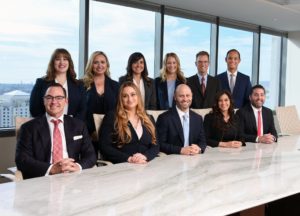Anyone in a position of leadership at an organization or institution that deals directly with children—be it concerned with education, health care, sports and recreation, arts, or community outreach—understands the critical importance of having a robust and effective child abuse prevention policy.
A successful policy keeps children safe not just while they are in the care of the organization or institution, but also in other parts of their lives. In contrast, an unsuccessful policy, whether it is substantively deficient or poorly implemented, constitutes a profound ethical and moral failure with horrific real-world consequences. In the worst cases, an ineffective child sexual abuse prevention policy gives false comfort to parents and the public, gives cover to would-be child abusers, and puts children in harm’s way.
Every institution and organization involving children should do its level best to implement sound, effective child sexual abuse prevention policies. In this blog post, we discuss some of the laws governing child sexual abuse prevention in California and offer suggestions for steps organizations and institutions can take to make the goal of 100 percent effective child sexual abuse prevention a reality. For more legal information talk to a California child sexual abuse lawyer at Gomez Trial Attorneys to answer any questions you may have.
Child Sexual Abuse Prevention Laws in California
The California Child Abuse & Neglect Reporting Act (CANRA) imposes mandatory child abuse reporting obligations on a wide range of persons whose employment brings them into contact with children or with information about children.
Generally speaking, “mandated reporters” of known or reasonably suspected child abuse (including sexual abuse) in California include virtually all teachers and school employees, child care providers, medical and mental health professionals, coaches, camp counselors, law enforcement officers and first responders, clergy, photo/video processors, and computer technicians.
We encourage anyone who is not sure if they are a “mandated reporter” under the law to read the definition of “mandated reporter,” here.
Most employees, contractors, and volunteers working with organizations and institutions that involve children in California likely fall within the statutory definition of “mandated reporters.” Accordingly, these organizations and institutions must train their employees, contractors, and volunteers in how to comply with their mandatory reporting obligations.
But that is not all organizations and institutions involving children must do to prevent child sexual abuse. To the extent employees, contractors, and volunteers have direct interaction with children, the organization/institution must also implement policies to ensure the safety of those children.
This entails developing rules and procedures to screen out would-be abusers, to set guidelines for behavior around children, to create child-safe environments, to educate children about recognizing and alerting an adult to problematic interactions, and to monitor interactions with children to ensure compliance.
Effective Mandated Reporter Training
California’s mandated reporter law, CANRA, places a significant amount of responsibility on the shoulders of staff and volunteers, asking them to absorb and respond to nuanced signs and signals from children in a wide variety of settings and contexts. This guide on mandated reporting requirements from the Rady Children’s Hospital San Diego, for example, acknowledges the breadth of the responsibility of a mandated reporter:
“Identifying evidence of child abuse requires first the understanding that child abuse can occur in any family, regardless of socio-economic status, religion, education, ethnic background, or other factors. Secondly, the professional must be aware of and alert to the signs of child abuse. Red flags for abuse and neglect are often revealed in environmental problems, individual parent or caregiver behaviors, family interactions, and physical and behavioral indicators in the child.”
Responsibility for identifying and accurately reporting child abuse may feel daunting to some people within an organization. That is why a primary goal of any effective mandated reporter training should be to provide clear and digestible information not just in a one-time setting, but as a resource that mandated reporters can access whenever they need it.
The California Office of Child Abuse Prevention offers free online training oriented toward specific professions and organizations. That is a good starting point for any mandated reporter training, but it need not be the end point. In its guide Preventing Child Sexual Abuse Within Youth-serving Organizations, the Centers for Disease Control and Prevention (CDC) advised that any training of staff or volunteers in child sexual abuse prevention should also “evaluate [a child sexual abuse prevention] policy to continuously measure whether goals are being met.”
In the context of training mandated reporters, that might include conducting refresher trainings, and incorporating child sexual abuse reporting topics into team meetings, posting and distributing information summarizing mandated reporting requirements, conducting periodic one-on-one check-ins with staff on reporting practices, and designated several child sexual abuse prevention point-persons to answer questions and provide guidance.
Effective Child Sexual Abuse Policies Beyond Mandated Reporter Training
The CDC guide linked above provides further guidance on elements of an effective child sexual abuse prevention policy that go beyond training employees, contractors, and volunteers. Below we summarize the highlights of the CDC’s recommendations:
Screening Staff and Volunteers
An effective child sexual abuse prevention policy must include robust procedures for screening any person who applies for a position that will involve interaction with children. The organization or institution should develop a list of screening criteria that would exclude not just would-be child abusers, but also anyone who might struggle to learn and follow mandated reporting requirements. It is also critical that an organization screen everyone.
Leaders should never make exceptions for friends, family, or someone they think they “know.” Not only is giving someone a pass on screening potentially dangerous for children, it also sends the wrong message throughout the organization about the inconsistency of standards.
According to the CDC, effective screening can include:
- Written applications that make clear the organization/institution’s child sexual abuse prevention priorities and that transparently requests information relevant to those priorities;
- In-person interviews to follow up on information provided in a written application and to assess the applicant’s “fit” for the position;
- Reference checks to confirm information provided and to obtain additional insight to the extent references will provide it;
- Criminal background checks that comply with local, state, and federal legal guidelines; and
- Online research, such as reviewing a person’s social media presence.
Personal Conduct Guidelines
Just because a person works for or with an organization or institution involving children, does not mean that person has a natural ease with children, or a clear and thorough understanding of appropriate behaviors around children. For wide-ranging social and cultural reasons, even the most well-meaning, caring adults may engage in behavior that unintentionally has negative outcomes for children.
 An organization or institution that serves children must set clear expectations for the behavior of its employees, contractors, and volunteers who interact with young people. These guidelines should not simply constitute a list of “dos” and “do nots.”
An organization or institution that serves children must set clear expectations for the behavior of its employees, contractors, and volunteers who interact with young people. These guidelines should not simply constitute a list of “dos” and “do nots.”
Rather, they should define and explain the parameters of appropriate conduct, so that staff and volunteers not only understand how they should act, but also why the organization expects them to act that way. A core component setting behavioral guidelines, according to the CDC, should include educating workers and volunteers about the “power differential between adults and youth and between youth leaders and youth.”
The guidelines should also establish easy-to-follow, practical parameters for interactions. The CDC suggests establishing ratios of children to adults in a given setting, defining a specific policy for one-on-one interactions between adults and kids both in and out of the organizational setting, and developing rules for interactions between children. It may also be appropriate to restrict certain activities altogether. And, of course, every organization should have contact information and, if possible, routine interaction with children’s caregivers.
Monitoring Practices
Effective monitoring to prevent child sexual abuse starts with having organizational/institutional knowledge of each-and-every potential interaction between an employee, contractor, or volunteer on one hand, and a child on the other. You cannot monitor what you do not know about. Organizations and institutions should also maintain clear lines of authority and communication, so that if someone “sees something,” they know exactly to which person(s) they should “say something”. the first step in assisting victims of child abuse is recognizing the signs and understanding what child abuse is.
Finally, organizations must keep effective records of their monitoring activities. These records, when adequately designed and incorporated into the routine of the organization or institution, enforce a certain discipline in monitoring behaviors, and can prove useful when an issue arises.
Child-Safe Organizational/Institutional Infrastructure
Finally, any organization involving children should give careful thought to the physical spaces its activities occupy, to ensure those spaces are child-friendly and maximally preventative of opportunities for sexual abuse. Ideally, an organization or institution should minimize places where adults and children could interact unseen by others, while also providing adequate facilities to protect privacy (such as places to change or shower) where necessary.
5 Ways Organizations and Institutions Fail
Merely having a child sexual abuse prevention policy is different from implementing it effectively. Organizations and institutions fail in their jobs of protecting children from sexual abuse for numerous reasons, most of which are neither purposeful nor malicious. Mere negligence or sloppiness in carrying out child sexual abuse prevention policies can put children at serious risk of harm. For example:
- Training failures, such as not ensuring that all mandated reporters have received training, lead to employees and others feeling unprepared for (or worse, being unaware of) their legal obligations under CANRA to report known or suspected child abuse;
- Screening lapses occur when an organization asks the wrong questions of applicants, or tries to save time and money by not checking references or conducting criminal background checks;
- Inappropriate conduct happens and goes unnoticed when an organization operates shorthanded, or when it fails to enforce (even for subjectively “sensible” reasons) guidelines for staff ratios or activity restrictions;
- Monitoring blind spots can appear when the leadership of an organization or institution delegates too much authority and decision-making to adults in positions of interaction with children; and
- Unsafe environments crop up whenever an organization attempts to fulfill its mission without appropriate financial or physical resources, and tries to “get by” on that, creating danger areas that would-be child-abusers might exploit.
These are just some of the ways a child sexual abuse prevention policies can fail. Again, in our experience, it is vanishingly rare for an organization to put children at risk of abuse knowingly or intentionally.
Far more often, an organization or institution with a positive and caring mission, staffed by well-meaning employees and volunteers, creates or perpetuates dangers for children unintentionally—perhaps by failing to create a well-formulated sexual abuse prevention policy, not following their own sexual abuse prevention policy, or giving favored employees a pass instead of taking credible allegations seriously. But even unintentionally created dangers can inflict profound, lifelong harm on an innocent child.
How Attorneys Can Help
Attorneys play a significant role in compelling organizations and institutions to implement more-effective child sexual abuse prevention policies. Organizations and institutions wanting to take proactive steps can retain an attorney to help review and ensure compliance with existing policies and practices. Unfortunately, not all organizations and institutions have the resources to retain legal counsel for that purpose.

More often, in our experience, attorneys play a significant role in identifying failures after they have occurred and a child has been harmed. Attorneys who represent victims of child sexual abuse, for example, often uncover serious failures in implementing a child sexual abuse prevention policy that, if they were addressed, would have protected the victim from sexual abuse.
In fact, in many cases in which an organization or institution faces legal liability for not preventing child sexual abuse, the motivation of the abuse survivor or the survivor’s family in bringing legal action is to force changes in how a child abuse prevention policy gets implemented to prevent harm coming to other children.
At Gomez Trial Attorneys, we would vastly prefer if organizations and institutions implemented effective child abuse prevention policies rather than the job falling to survivors and their lawyers to bring about necessary change. Until that happens, however, we stand ready to help survivors and their families seek accountability and justice for child sexual abuse through the California legal system.
To learn more about your rights after the preventable tragedy of child sexual abuse has harmed you or a family member, an experienced Southern California child sexual abuse injury attorney can answer your questions.







